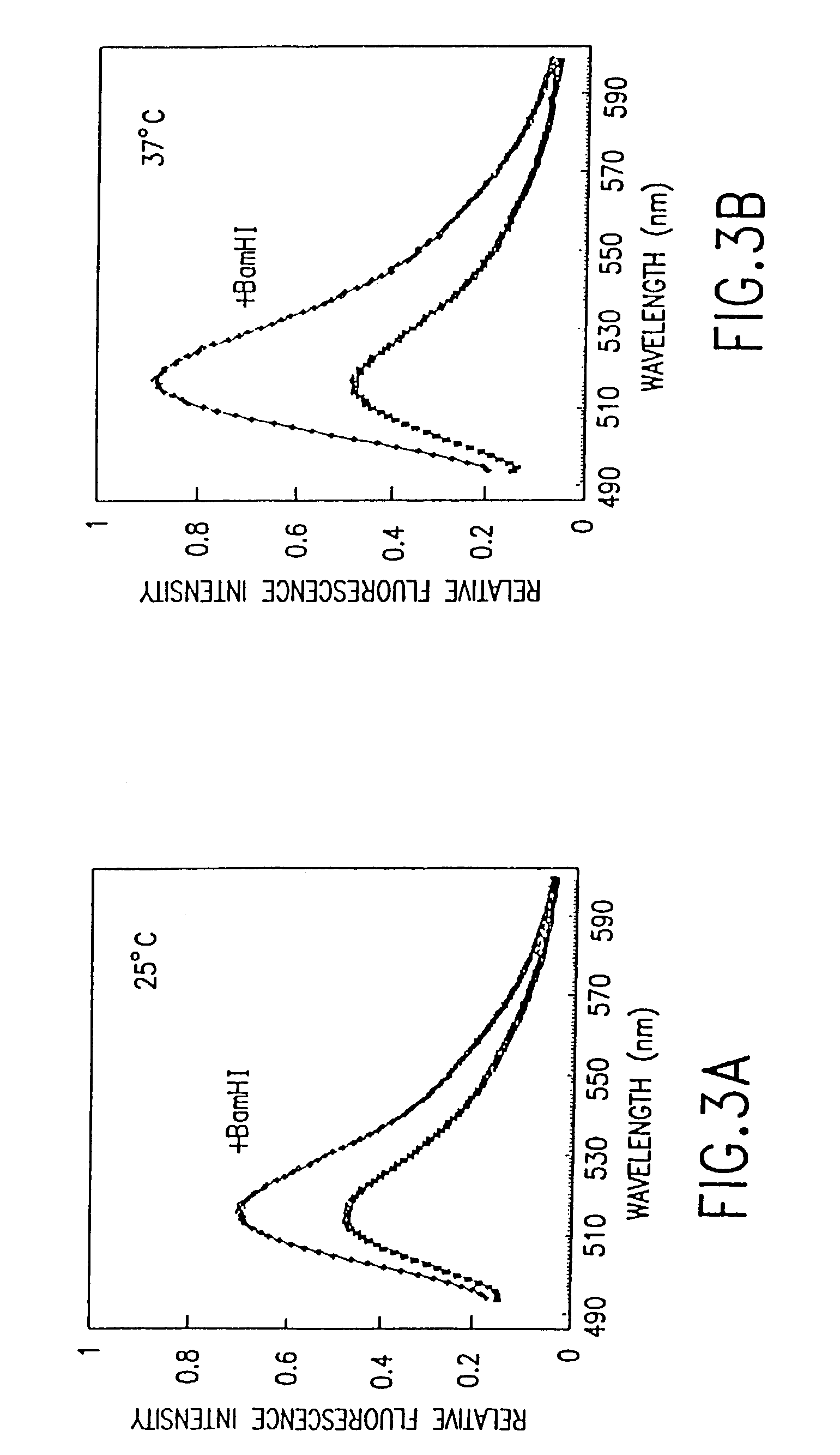Fluorometric assay for detecting nucleic acid cleavage
- Summary
- Abstract
- Description
- Claims
- Application Information
AI Technical Summary
Benefits of technology
Problems solved by technology
Method used
Image
Examples
example 1
Fluorometric Assay for Detecting Nucleic Acid Cleavage by the Restriction Enzyme, BamHI
Materials
[0056]FITC and 5-carboxyfluorescein were obtained from Molecular Probes (Eugene, Oreg.). The BamHI restriction enzyme was purchased from New England Biolab. Aminolink 2 and reagents for oligonucleotide synthesis were obtained from Applied Biosystems. DNase I was obtained from Worthington Enzymes.
Methods
[0057]Preparation of fluorescent-labeled oligonucleotides: Aminolink 2 is a commercially available modified base that can be directly introduced into oligonucleotides with a DNA synthesizer. This reagent introduces an aliphatic primary amine at the 5′ ends of oligonucleotides. Accordingly, a 14-mer aminolink oligonucleotide, 5′-NH2-CCCCGGATCCACCC-3′ (SEQ ID NO:1), containing the BamHI restriction site GGATC, and its complementary strand without aminolink, 3′-GGGGCCTAGGTGGG-5′ (SEQ ID NO:2), were synthesized using an Applied Biosystems 380B DNA synthesizer. The oligonucleotides were purified...
example 2
Fluorometric Assay for Detecting Nucleic Acid Cleavage Mediated by HIV-Integrase
Materials
[0077]5-Amino (12)-2′-deoxyuridine β-cyanoethyl phosphoramidite was obtained from Molecular Biosystems, Inc. FITC, EITC, 5-carboxyfluorescein, and 1,8-ANS were purchased from Molecular Probes. [γ-32P]ATP was obtained from ICN. T4 polynucleotide kinase was obtained from New England Biolabs. Ni2+-charged metal chelating resin was purchased from Novagen.
Methods
[0078]Preparation of HIV-IN protein: The wild-type HIV-integrase protein was obtained from Dr. Robert Craigie (Laboratory of Molecular Biology, National Institute of Diabetes and Digestive and Kidney Diseases, Bethesda, Md.). The protein was overexpressed in Escherichia coli and purified according to previously-described procedures. (Sherman and Fyfe, Proc. Natl. Acad. Sci. USA 87:5119–5123 (1990)).
[0079]Preparation of Oligonucleotides and Fluorescent Labeled DNA Substrate for HIV-IN: Oligonucleotides containing the terminal sequence of HIV-1...
example 3
Fluorometric Assay for Detecting Nucleic Acid Cleavage Occurring During Catalytic Hybridization Amplification (CHA)
[0101]“Catalytic hybridization amplification” (CHA), alternatively known as “cycling probe technology,” is described in published PCT application WO 89 / 09284, and U.S. Pat. Nos. 5,011,769 and 4,876,187. Briefly, CHA is an improved hybridization assay method whereby the target sequence to be detected is able to capture many molecules of the probe in a repeating series of reactions (i.e., “cycling probe”). Essentially, enzyme mediated cleavage of the probe within the probe target duplex results in release of the intact target sequence, which can repeatedly recycle through the reaction pathway. The target sequence serves as a catalytic cofactor for the cleavage of a complementary, labeled nucleic acid probe that is hybridized to the target. The detectable signal in this reaction results from cleavage of the probe, e.g., after repeated CHA cycles, one measures the labeled p...
PUM
| Property | Measurement | Unit |
|---|---|---|
| Fraction | aaaaa | aaaaa |
| Fraction | aaaaa | aaaaa |
| Fraction | aaaaa | aaaaa |
Abstract
Description
Claims
Application Information
 Login to View More
Login to View More - R&D
- Intellectual Property
- Life Sciences
- Materials
- Tech Scout
- Unparalleled Data Quality
- Higher Quality Content
- 60% Fewer Hallucinations
Browse by: Latest US Patents, China's latest patents, Technical Efficacy Thesaurus, Application Domain, Technology Topic, Popular Technical Reports.
© 2025 PatSnap. All rights reserved.Legal|Privacy policy|Modern Slavery Act Transparency Statement|Sitemap|About US| Contact US: help@patsnap.com



